Widely recognized as the Windy City, Chicago is a bustling metropolis that receives millions of visitors every year. World-class facilities, fine dining, and diverse culture are the major sources of attraction.
At the heart of this vibrant city, there are two primary international airports that serve as the gateway to the rest of the world. Chicago O’Hare International Airport (ORD) and Chicago Midway International Airport (MDW) are the two international airports playing a vital role in connecting the windy city to the rest of the country and the world.
In addition to the key international airports, there are more than 6 other airports in Chicago including regional airports, municipal, airports, private airports, and more.
In this article, we will take a closer look at all the airports in Chicago, their history, features, and services, and everything you need to know.
So, fasten your seatbelts and get ready to take off on a journey through the airports of Chicago.
Table of Contents
2 Major International Airports in Chicago
Chicago O’Hare International Airport (ORD), and Chicago Midway Airport (MDW) are the two key international airports serving flights to domestic, and international destinations from Chicago.
Let’s explore these airports in detail.
Chicago O’Hare International Airport (ICAO: KORD, IATA: ORD, FAA LID: ORD)
Chicago O’Hare International Airport is located on the Northwest side of Chicago, Illinois which is 23 km northwest of the Loop business district. The airport is commonly known as O’Hare Airport, O’Hare, or Chicago O’Hare. The Chicago Department of Aviation (CDA) handles the overall operation of O’Hare International Airport. It is among the busiest international airports in Chicago.
The airport designed to be the successor of Chicago Midway International Airport covers a total area of 7,627 acres (3,087 ha) of land. The airport operates flights to over 228 destinations across the globe including European countries, South America, North America, Africa, Asia, and Oceania.
History of O’Hare International Airport
O’Hare was a manufacturing plant for World War II aircraft ‘Douglas C-54 Skymasters’ where almost 655 C-54s planes were manufactured. The field attached with the plant was known as Douglas Airport and the manufactured planes were flown.
The Douglas Airport or airfield featured four runways each with a length of 1,700 meters. After the conclusion of the second world war, the Douglas Company’s contract expired and it chose to work only at its headquarters in Santa Monica, California. The name of the airport was changed to ‘Orchard Field Airport’ with IATA code ‘ORD’ after the departure of Douglas Company.
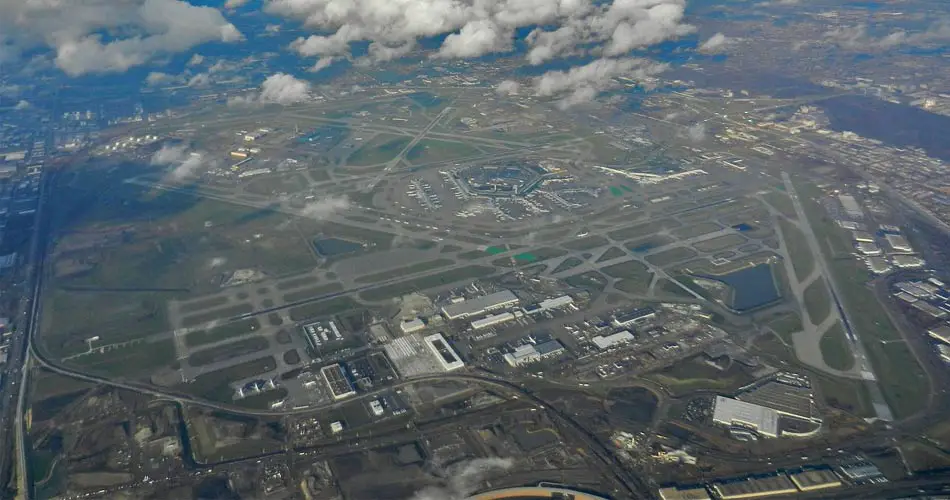
Explore 4 major airports in the US Virgin Islands (USVI)
The Orchard Field Airport was then utilized by the United States Air Force during the Korean War due to which no commercial flights occurred at the airport. The airfield became home to US Air Force 62nd Fighter-Interceptor Squadron which operated North American F-86 Sabres from 1950 to 1959.
The airport slowly gained momentum in commercial business starting in 1960 due to which the need for a fighter base declined. With that, the US Air Force reserve fighter base was closed on 1st April 1997 under the agreement between the Department of Defense, and the O’Hare City authority.
After the termination of the fighter base, the airport went through various advancements for scheduled commercial flights. O’Hare became the first airport to use the jet bridge in 1958 and also use slip-form paving for concrete and strong runways.
The name was finalized O’Hare Airport by the city in 1949 to honor Edward ‘Butch’ O’Hare. Edward was the U.S. Navy’s first flying ace and Medal of Honor recipient in the second World War.
The O’Hare Airport initiated scheduled passenger service in 1955 with a project investment of over US$25 million. The airport started to lure airlines after the first dedicated international terminal was inaugurated in August 1958. After that, the area expanded to 7,200 acres (2,900 ha) with the introduction of new terminals, parking, an apron, aircraft hangars, and various other infrastructural facilities.
Terminal 2 and Terminal 3 were introduced on January 1, 1962, and were designed by C.F. Murphy and Associates.
One of the biggest achievements of the airport was the first scheduled jet operation. American Boeing 707 conducted flights from New York to Chicago to San Francisco on 22nd March 1959. Midway International Airport, the airport next to O’Hare, was facing issues with limited infrastructure as it did not have a required runway to accommodate Boeing 707 and Douglas DC-8 aircraft. With that, O’Hare airport became the center of attraction for various airlines and served over 10 million passengers annually becoming the world’s busiest airport.
The airport went through various developments after the passage of US airline deregulation in the 1980s. Trans World Airlines (TWA) terminated its hub from O’Hare and shifted towards St. Louis. Northwest Airlines Corp. (NWA) also moved toward Minneapolis; however, Delta kept its hub in Chicago for some time. Delta closed its hub at Chicago Airport in the 1990s due to the expense of O’Hare Airport.
O’Hare airport experienced delays from the late 1980s due to inefficient runway layout as only one new runway (4R/22L) was added in 1971. The three pairs of angled runways of O’Hare airport allowed takeoffs into the wind; however, they were dangerous and inefficient.
In the 1990s, the airport got the title of one of the worst-performing airports in the United States due to the increment in delayed flights. The airport went through O’Hare Modernization Plan (OMP) after CDA committed to it in 2001. The financial issues in 2008 delayed the OMP completion and the construction of the sixth and final parallel runway (9C/27C) initiated in 2016.
The parallel runway project will be completed in November 2020 and the extension of runway 9R/27L is scheduled to complete in 2021.
United Airlines and American Airlines operate their flights from the base at O’Hare International Airport today. After the initialization and completion of the first two phases of OMP, the airport saw a reduction in system delays by almost 57 percent. With that, the airport ranked 14th position for maintaining on-time performance in 2017 among the top 30 U.S. airports. The initial project cost estimation was US$6.6 billion however, it escalated beyond US$10 billion by 2019.
Facilities at O’Hare International Airport
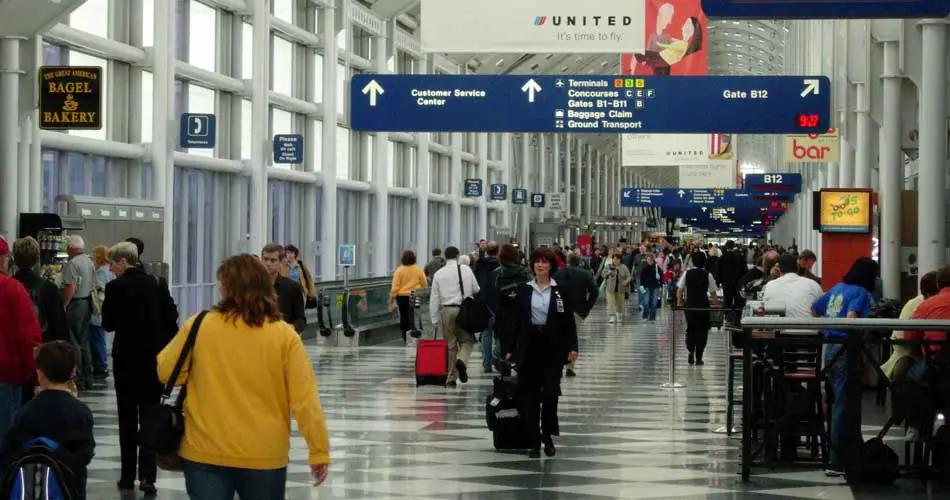
Terminals
The Chicago O’Hare International Airport is among the major international airports in Chicago so, it holds four passenger terminals named Terminal 1, Terminal 2, Terminal 3, and Terminal 5. These terminals feature nine lettered concourses and a total of 191 gates.
Terminals 1-3 are interconnected airside whereas Terminal 5 is separated by a set of taxiways that allows passengers to exit security, ride a shuttle bus, and re-clear security before boarding.
| TERMINAL | INFRASTRUCTURE |
| Terminal 1 | 50 gates across two concourses (lettered B-C) |
| Terminal 2 | 41 gates on two concourses (lettered E-F) |
| Terminal 3 | 79 gates on four concourses (lettered G, H, K, L) |
| Terminal 5 | 21 gates on one concourse (lettered M) |
Airlines Facilities at the Terminal
| TERMINAL | AIRLINE FACILITIES |
| Terminal 1 | United Airlines United Clubs and Polaris Lounge |
| Terminal 2 | United Airlines United Clubs, Delta Sky Club |
| Terminal 3 | American Admirals Club |
| Terminal 5 | Foreign Carrier lounges (Air France, British Airways, Swiss, SAS, Korean Air) |
O’Hare International Airport Runway Information
Chicago O’Hare International Airport features two sets of parallel runways that are built on either side of the terminal complex.
| RWY DESIGNATION | Length (ft) | Length (m) | Surface |
| 4L/22R | 7,500 | 2,286 | Asphalt |
| 4R/22L | 8,075 | 2,461 | Asphalt |
| 9L/27R | 7,500 | 2,286 | Concrete |
| 9C/27C | 11,245 | 3,428 | Concrete |
| 9R/27L | 7,967 | 2,428 | Asphalt/concrete |
| 10L/28R | 13,000 | 3,962 | Asphalt/concrete |
| 10C/28C | 10,801 | 3,292 | Concrete |
| 10R/28L | 7,500 | 2,286 | Concrete |
Airlines Operating at Chicago O’Hare International Airport
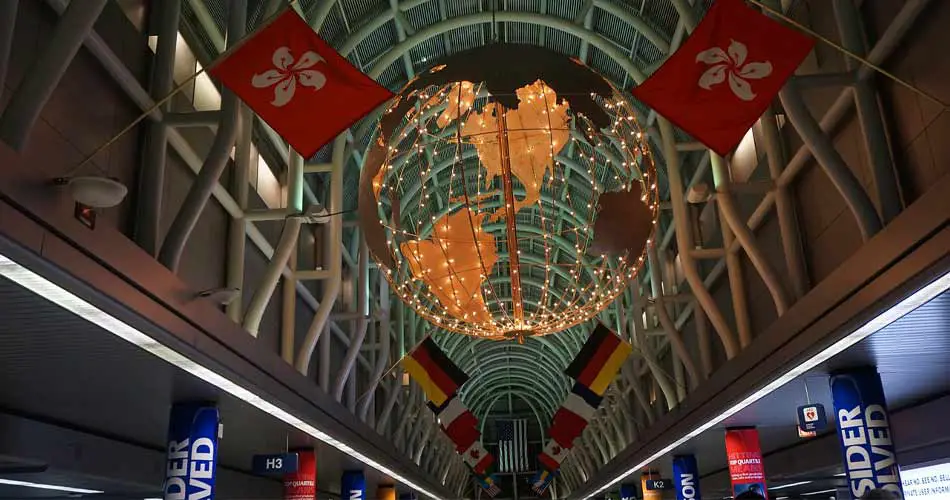
List of Airlines Operating at O’Hare International Airport
- Aer Lingus, Aeromexico, Air Canada, Air Canada Express, Air Choice One, Air France, Air India, Air New Zealand, Alaska Airlines, All Nippon Airways, American Airlines, American Eagle, Austrian Airlines
- British Airways, Boutique Air
- Cape Air, Cathay Pacific, China Eastern Airlines, Copa Airlines
- Delta Air Lines, Delta Connection, Denver Air Connection
- Emirates, Ethiopian Airways, EVA Air
- Finnair, Frontier Airlines
- Hainan Airlines
- Iberia Airlines, Icelandair
- Japan Airlines, JetBlue
- KLM, Korean Air
- LOT Polish Airlines, Lufthansa
- Royal Jordanian
- Scandinavian Airlines, Southwest Airlines, Spirit Airlines, Sun Country Airlines, Swiss International Air Lines
- TAP Air Portugal, Turkish Airlines
- United Airlines, United Express
- VivaAerobus, Volaris
O’Hare Busiest International Routes
| DESTINATION | AIRLINES |
| London-Heathrow | American, British Airways, United Airlines |
| Toronto-Pearson | Air Canada, American, United Airlines |
| Cancun | American, Frontier, Spirit, United Airlines |
| Frankfurt | Lufthansa, United Airlines |
| Mexico City | Aeroméxico, Interjet , United Airlines, Volaris |
| Tokyo-Narita | All Nippon, JAL, United Airlines |
| Dublin | Aer Lingus, American, United Airlines |
| Munich | Lufthansa, United |
| Istanbul | Turkish Airlines |
| Vancouver | Air Canada, American Airlines, United Airlines |
Chicago O’Hare International Airport Technical Information
| ICAO Code | KORD |
| IATA Code | ORD |
| FAA LID | ORD |
| Elevation | 668 ft above mean sea level (204m) |
| Runway | 4L/22R 4R/22L 9L/27R 9C/27C 9R/27L 10L/28R 10C/28C 10R/28L |
| Helipad | H1 (200 ft) |
| Terminal | Terminal 1,2,3 and 5 |
Chicago Midway International Airport (ICAO: KMDW, IATA: MDW, FAA LID: MDW)
The Chicago Midway International Airport is a major commercial airport located on the southwest side of Illinois which is approximately 19 km away from the Loop business district. The airport is commonly known as the Chicago Midway, Midway Airport, or simply Midway and is among the major international airports in Chicago.
The airport was operating as the busiest and primary airport in Chicago until the operation of O’Hare International Airport in 1955. It is the busiest airport in the Chicago metropolitan area after O’Hare Airport and serves over 20 million passengers annually.
History of Midway International Airport
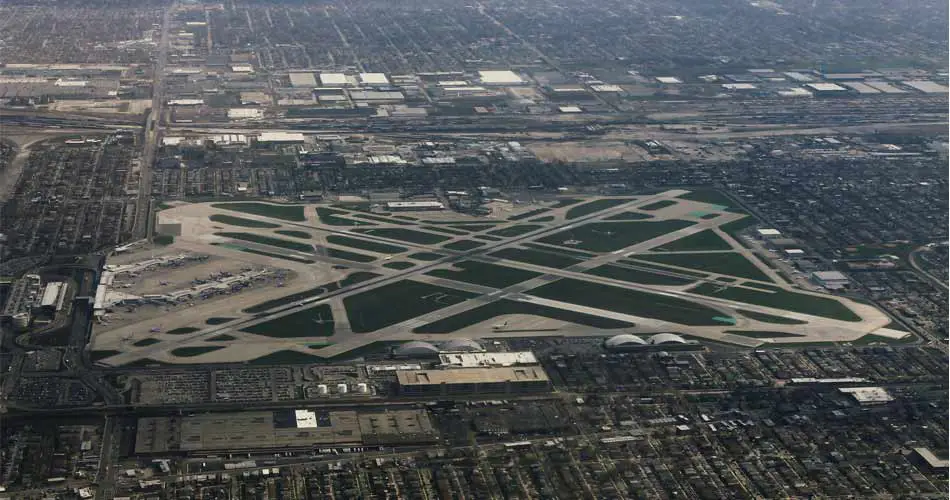
The Chicago Midway International Airport was originally known as Chicago Air Park. The airport was constructed on 320-acre (130 ha) land in 1923 with only one cinder runway to facilitate airmail flight operations. The name was reformed to Chicago Municipal Airport on December 12, 1927, after the Chicago city leased the airport in 1926.
The airport saw some major changes by 1928 including 12 hangars, and four runways with lighting equipment for night flight operations. Due to a major fire incident on 25th June 1930, two hangars and 27 aircraft were destroyed at the airport and the loss was estimated at over US$2 million.
The airport went through various development projects including a new passenger terminal in 1931. The name of the airport was changed to the Battle of Midway in July 1949.
The reconstruction project began in 1967 in which the airport encountered the addition of three new concourses with 28 gates and three ticket counters. Chicago city invested almost US$10 million in Midway Airport renovation funds.
Midway International Airport was capable of handling aircraft like Douglas DC-9, Boeing 727, Boeing 737, BAC One-Eleven however, the runway was inefficient for Boeing 707 and Douglas DC-8. Due to this limitation, the majority of airlines preferred O’Hare International Airport.
Chicago Midway International Airport Runway Information
The Midway International Airport features five runways including RWY 13C/21C, RWY 4R/22L, RWY 4L/22R, RWY 13L/31R, and RWY 13R/31L.
| RUNWAY DESIGNATION | LENGTH |
| 4L/22R | 5,507 ft (1,679m) |
| 4R/22L | 6,445 ft (1,964m) |
| 13C/31C | 6,522 ft (1,988m) |
| 13L/31R | 5,141 ft (1,567m) |
| 13R/31L | 3,859 ft (1,176m) |
Facilities at the Chicago Midway International Airport
The Chicago Midway International Airport features a terminal with three concourses; Concourse A, Concourse B, and Concourse C. There are a total of 43 aircraft gates on these three different concourses.
| CONCOURSE | NUMBER OF GATES |
| Concourse A | 19 gates |
| Concourse B | 26 gates |
| Concourse C | 3 gates |
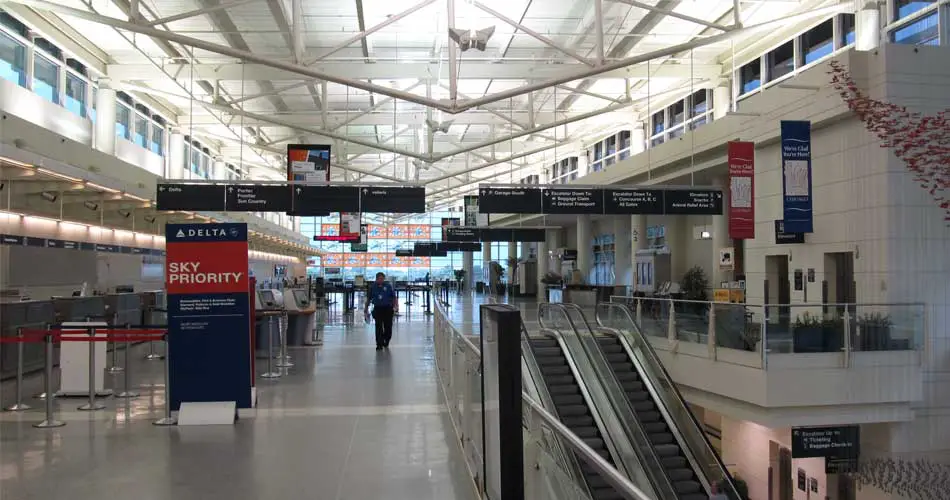
Airlines operating at Midway International Airport
- Allegiant Air
- Delta Air Lines, Delta Connection
- Porter Airlines
- Southwest Airlines
- Volaris
Busiest Domestic Destination
| DESTINATION | OPERATING AIRLINES |
| Las Vegas, Nevada | Southwest Airlines |
| Phoenix-Sky Harbor, Arizona | Southwest Airlines |
| Orlando, Florida | Southwest Airlines |
| Atlanta, Georgia | Delta, Southwest Airlines |
| Denver, Colorado | Southwest Airlines |
| Dallas-Love, Texas | Southwest Airlines |
| Tampa, Florida | Southwest Airlines |
| Houston-Hobby, Texas | Southwest Airlines |
| Fort Myers, Florida | Southwest Airlines |
| Minneapolis/St.Paul, Minnesota | Delta Air Lines, Southwest Airlines |
Busiest International Destinations
| DESTINATION | OPERATING AIRLINES |
| Toronto-Billy Bishop, Canada | Porter Airlines |
| Cancun, Mexico | Southwest Airlines |
| Morelia, Mexico | Volaris |
| Guadalajara, Mexico | Volaris |
| Montego Bay, Jamaica | Southwest Airlines |
| Punta Cana, Dominican Republic | Southwest Airlines |
| Leon/Del Bajio, México | Volaris |
| Zacatecas, Mexico | Volaris |
| Durango, Mexico | Volaris |
| Queretaro, Mexico | Volaris |
Chicago Midway International Airport Technical Information
| ICAO Code | KMDW |
| IATA Code | MDW |
| FAA LID | MDW |
| Elevation | 620 ft above mean sea level (189m) |
| Runway | 4L/22R 4R/22L 13C/31C 13L/31R 13R/31L |
| Terminal | Concourse A, Concourse B, and Concourse C |
Chicago Rockford International Airport (ICAO: KRFD, IATA: RFD, FAA LID: RFD)
Chicago Rockford Int’l Airport (RFD) is commonly known as Rockford Int’l or just Chicago Rockford. Located in Rockford (Illinois), the airport services Rockford, and the Chicago Metropolitan area.
Although Rockford Airport is not located within the city limits of Chicago, it is still considered a part of the Chicago Metropolitan Area. This is because RFD serves as a convenient alternative to Chicago’s busier international airports while also serving as a significant transportation and economic hub for the region.
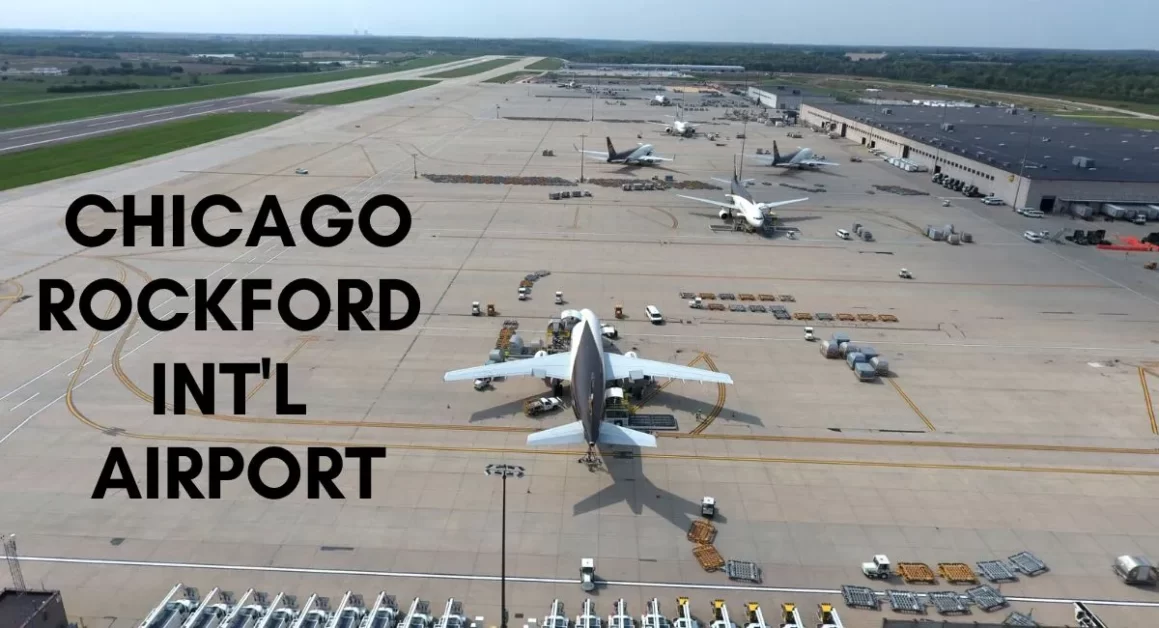
History of the RFD Airport
Rockford International Airport was originally built as a small municipal airport in 1946 and has undergone several renovations and expansions over the years. During the early operations, RFD served the Rockford community with limited commercial and private air service. The airport has now become one of the fastest-growing cargo airports in the United States.
Over the years, the airport has undergone several transformations and expansions, including the construction of a new terminal building in the 1980s and a runway extension in the 1990s. These improvements allowed the airport to attract more commercial airlines and expand its cargo operations.
In the early 2000s, the airport’s cargo operations began to take off, thanks to its strategic location near major highways and railroads, as well as its proximity to the Chicago metropolitan area. In 2003, the airport was designated a Foreign Trade Zone, which allowed companies to import and export goods with reduced or eliminated tariffs, further boosting its cargo operations.
Since then, the airport has become a critical player in the region’s economy, serving as a hub for cargo operations for companies like UPS, DHL, and Amazon, among others. Today, the airport is one of the fastest-growing cargo airports in the United States, handling millions of pounds of cargo each year.
Facilities at Chicago Rockford International Airport
Situated at an elevation of 741 ft (226 m) above mean sea level (AMSL), RFD features two asphalt runways with the designation Rwy 01/19, and Rwy 07/25.
Talking about the terminal facility, RFD is equipped with an international terminal that handles both passenger, and cargo operations.
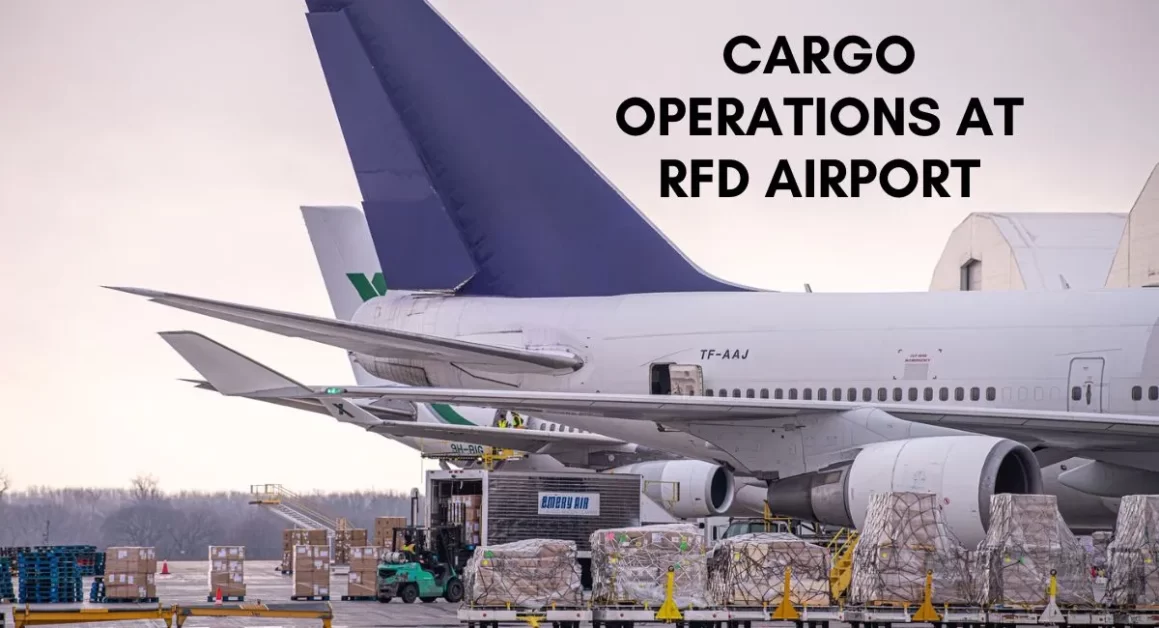
Airlines at RFD Airport
At present, Allegiant Air is the only commercial airline operating passenger flights to and from RFD Airport. Cargo operations are carried out by Amazon Air, Korean Air Cargo, and UPS Airlines.
Allegiant Air connects Rockford with various destinations in the United States including Ft. Myers/Punta Gorda (Florida), Las Vegas (Nevada), Orlando/Sanford (Florida), Phoenix/Mesa (Arizona), Sarasota (Florida), and Tampa/St. Petersburg (Florida).
Rockford International Airport Technical Information
| ICAO Code | KRFD |
| IATA Code | RFD |
| FAA LID | RFD |
| Elevation | 742 ft (226 m) AMSL |
| Runway | 01/19 (Asphalt) 07/25 (Asphalt/Concrete) |
Other airports in Chicago (General Aviation, Public-use, and Municipal Airports)
There are various other airports in Chicago including general aviation airports, flight training airfields, municipal airports, public-use airfields, and more.
Gary/Chicago International Airport, Lansing Municipal Airport, DuPage Airport, and Chicago Executive Airport are some of the important airports in Chicago.
Gary/Chicago International Airport (ICAO: KGYY, IATA: none, FAA LID: GYY)
The Gary/Chicago International Airport is a joint civil-military public airport located in Gary, Lake Country, Indiana. The airport is situated three miles northwest of the city center of Gary and 40 km southeast of the Chicago Loop.
The airport operates under the supervision of the Gary/Chicago International Airport Authority. It features two runways with the designation RWY12/30 and RWY 2/20.
History of the Gary/Chicago International Airport
The Gary/Chicago International Airport is among the international airports in the Chicago metropolitan area that supports two other major airports; O’Hare and Midway International Airport.
Major companies including Boeing, Menards, and White Lodging Services base their corporate aircraft in this airport. The expansion of the Gary/Chicago International Airport turned out to be an alternative to constructing a new airport near Peotone, Illinois located 30 miles south of Chicago.
The airport acquired the approval of US$48 million in funding in 2006 (funding for ten years) to make it Chicago’s third major airport.
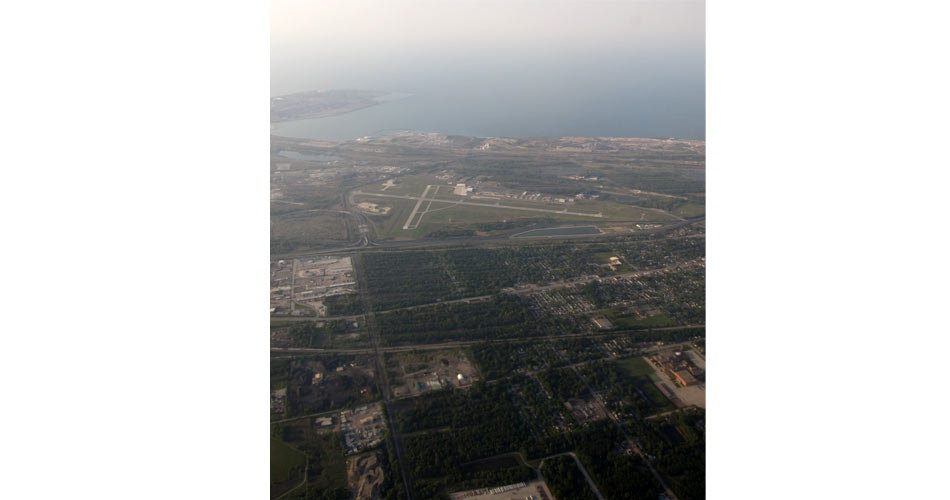
The Federal Aviation Authority (FAA), the aviation regulatory body of the United States warned to close the airport’s control tower in accordance with the Federal Budget Sequestration in 2013 however, the closure didn’t happen after Allegiant Air planned to continue scheduled flights.
The runway 12/30 was extended from 7,003 feet to 8,859 feet in the north section and opened for service on June 25, 2015.
Facilities at the Gary/Chicago International Airport
The Gary/Chicago International Airport situated at an elevation of 597 feet (180m) above mean sea level occupies 763 acres (309 ha) of land. The airport features two asphalt runways with the designation RWY12/30 and RWY 2/20 and is among the international airports in Chicago.
The airport offers enough space for parking aircraft. There were 111 aircraft based at this airport in January 2017.
Gary/Chicago International Airport Runway Information
| RUNWAY DESIGNATION | LENGTH |
| RWY 12/30 | 8,859 ft (2,700m) |
| RWY 2/20 | 3,604 ft (1,098m) |
Flight Operations
Pan Am, SkyValue Airlines, Skybus Airlines, Hooters Air, and Southeast Airlines operated flights from Gary/Chicago International Airport to various destinations including Hartford, Florida, St. Petersburg, Connecticut, Greensboro, Myrtle Beach, South Carolina, and North Carolina. However, commercial flights were closed due to the low demand for flights.
Only cargo flights are operated at the airport. AirNet Express operates cargo services connecting Cleveland, and Columbia whereas UPS Airlines flies to Louisville and Philadelphia.
Gary/Chicago International Airport Technical Information
| ICAO Code | KGYY |
| IATA Code | – |
| FAA LID | GYY |
| Elevation | 597 ft above mean sea level (182m) |
| Runway | 12/302/20 |
DuPage Airport (ICAO: KDPA, IATA: DPA, FAA LID: DPA)
DuPage (DPA) is a public-use airport located approximately 30 miles west of Chicago’s downtown area. The airport primarily serves as a general aviation facility including aircraft maintenance & repair facilities, fueling services, flight training schools, aircraft charter, concierge services, aviation consulting firms, and various other aviation-related businesses.
Originally established in the 1920s, the airport has undergone several transformations over the years, including the construction of a new terminal building in the 1990s and the addition of new hangars and other facilities in the 2000s. Today, the airport is one of the busiest general aviation airports in the United States, handling thousands of aircraft operations each year.
DPA sits at an elevation of 759 ft (231.2 m) above mean sea level (AMSL) and features four runways with the designations Rwy 2L/20R, Rwy 2R/20L, Rwy 10/28, and Rwy 15/33.

At the airport, a Fixed Base Operator (FBO) provides various services, including fuel and aircraft parking, de-icing, catering, and lavatory facilities. Transient crews and passengers can take advantage of several amenities such as courtesy cars, passenger terminal, lounges, snooze rooms, showers, and an exercise room. Additionally, the airport has a flight school that offers services like flight training, aircraft rental, aerial tours, pilot supplies, and aircraft maintenance and management.
DPA Technical Information
| ICAO Code | KDPA |
| IATA Code | DPA |
| FAA LID | DPA |
| Elevation | 759 ft (231.2 m) AMSL |
| Runway | 2L/20R (Concrete) 2R/20L (Concrete) 10/28 (Asphalt) 15/33 (Asphalt) |
Chicago Executive Airport (ICAO: KPWK, IATA: PWK, FAA LID: PWK)
Chicago Executive (PWK) is also a public-use airport located 18 miles northwest of Chicago. The airport is owned and operated by the City of Prospect Heights, and the Village of Wheeling, and primarily serves Chicago.
Chicago Executive Airport was formerly known as Palwaukee Municipal Airport. Pal-Waukee was named in November 1928 as the airport opened in 1925 as Gauthier’s Flying Field.
The airport offers general aviation services such as fueling, FBOs, aircraft hangars, military operations, and various other aviation-related businesses.
Talking about the infrastructure, The airport covers 411 acres (166 ha) at an elevation of 647 feet (197 m). It has three asphalt paved runways: 6/24 is 3,677 by 50 feet (1,121 x 15 m); 12/30 is 4,415 by 75 feet (1,346 x 23 m); 16/34 is 5,001 by 150 feet (1,524 x 46 m).

Regarding the airport’s physical features, it encompasses 411 acres (166 hectares) of land, sitting at an altitude of 647 feet (197 meters). The airport is equipped with three runways made of asphalt paving. These include runway 6/24, measuring 3,677 by 50 feet (1,121 x 15 meters); runway 12/30, measuring 4,415 by 75 feet (1,346 x 23 meters); and runway 16/34, measuring 5,001 by 150 feet (1,524 x 46 meters).
DPA Technical Information
| ICAO Code | KPWK |
| IATA Code | PWK |
| FAA LID | PWK |
| Elevation | 647 ft (197 m) AMSL |
| Runway | 16/34 (Asphalt) 12/30 (Asphalt) 6/24 (Asphalt) |
Lansing Municipal Airport (ICAO: KIGQ, FAA LID: IGQ)
Lansing Municipal (IGQ) is among the public-use airports in Chicago located 21 miles south of Chicago, in Lasing. The airport is owned and operated by the Village of Lansing.
The airport is situated at an elevation of 620 ft (189 m) above mean sea level (AMSL), and features two asphalt runways with the designations Rwy 9/27, and Rwy 18/36.
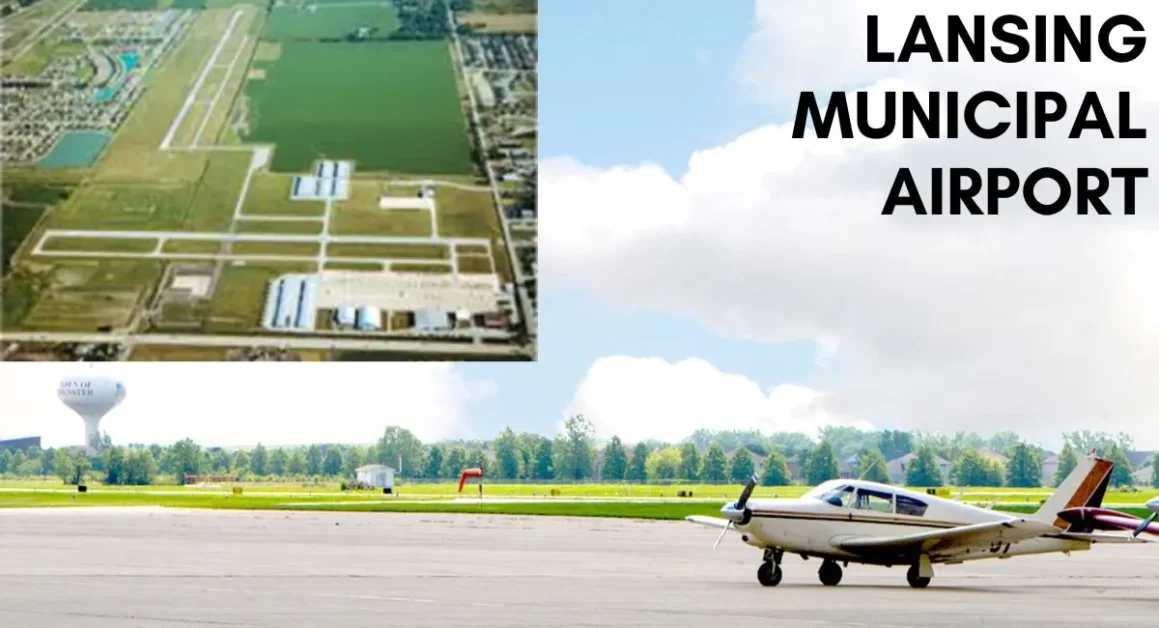
Lansing Municipal Airport offers general aviation facilities, and is the home to a number of flight training schools. It is also a primary hub for student pilots.
IGQ Technical Information
| ICAO Code | KIGQ |
| IATA Code | – |
| FAA LID | IGQ |
| Elevation | 620 ft (189 m) AMSL |
| Runway | 9/27 (Asphalt) 18/36 (Asphalt) |
Airports near Chicago
If you are searching for nearby airports, there are several airports near Chicago that can be your alternative choice.
| AIRPORTS NEAR CHICAGO | DISTANCE FROM CHICAGO |
| Joilet Regional Airport | 44 miles |
| Waukegan Regional Airport | 45 miles |
| General Mitchell International Airport (MKE) | 85 miles |
| South Bend Regional Airport (SBN) | 92 miles |
| Fort Wayne International Airport (FWA) | 174 miles |
| Gerald R. Ford International Airport (GRR) | 183 miles |
Conclusion on the Airports in Chicago
In conclusion, Chicago is a major transportation hub served by several airports, with O’Hare International Airport being one of the busiest airports in the world. Whether you’re a business traveler, tourist, or just passing through, Chicago’s airports offer a range of options to fit your needs.
From the convenience of Midway International Airport to the regional options of Chicago Rockford International Airport and Gary/Chicago International Airport, there are plenty of choices for travelers flying in and out of Chicago.
With numerous flight options and competitive prices, these airports make traveling to and from Windy City easier and more accessible than ever.
To wrap up, here are the lists of significant airports in Chicago.
- O’Hare International Airport (ORD) – located about 17 miles northwest of downtown Chicago, it is one of the busiest airports in the world.
- Midway International Airport (MDW) – located about 10 miles southwest of downtown Chicago, it is a smaller airport mainly used by low-cost airlines.
- Chicago Rockford International Airport (RFD) – located about 85 miles northwest of downtown Chicago, it is a smaller regional airport.
- Chicago Executive Airport (PWK) – located about 18 miles north of downtown Chicago, it is a general aviation airport mainly used for private and corporate flights.
- Gary/Chicago International Airport (GYY) – located about 25 miles southeast of downtown Chicago, it is a smaller regional airport mainly used for cargo and general aviation.
- Milwaukee Mitchell International Airport (MKE) – located about 90 miles north of downtown Chicago, it is a larger airport serving the Milwaukee area and also serves as an alternative to O’Hare and Midway for some travelers.
How many airports are in Chicago?
There are two major international airports in Chicago including the busiest Chicago O’Hare International Airport (ORD), and Chicago Midway International Airport (MDW). Besides, there are various other general aviation airports, private, and public-use airports in Chicago.
Is it better to fly into Midway or O’Hare?
Chicago Midway is closer to the center of Chicago City so, it may be your best destination for quicker access. However, Chicago O’Hare is served by more airlines compared to Midway. MDW airport is a smaller international airport in comparison to O’Hare airport. So, you can use O’Hare airport for more flexibility, and MDW airport as an alternative.
Which Chicago Airport is closer to the city?
Chicago Midway International Airport (MDW) is closer to the city as it is just 10.7 miles away. On the other hand, Chicago O’Hare International Airport (ORD) is 16.9 miles away from the city.
What’s the other airport in Chicago besides O Hare?
Chicago Midway International Airport (MDW) is another key international airport in Chicago after O’Hare International Airport (ORD).






[…] Chicago O’Hare International Airport is one of the busiest airports in USA located on the Northwest side of Chicago, Illinois, 23 km northwest of the Loop business district. The airport is commonly known as O’Hare Airport, O’Hare, or Chicago O’Hare. The Chicago Department of Aviation (CDA) handles the overall operation of O’Hare International Airport. It is among the busiest international airports in Chicago. […]
[…] Chicago O’Hare International Airport […]
[…] Douglas International AirportChicago-O’Hare International AirportDallas/Fort Worth International AirportLos Angeles International AirportMiami International […]